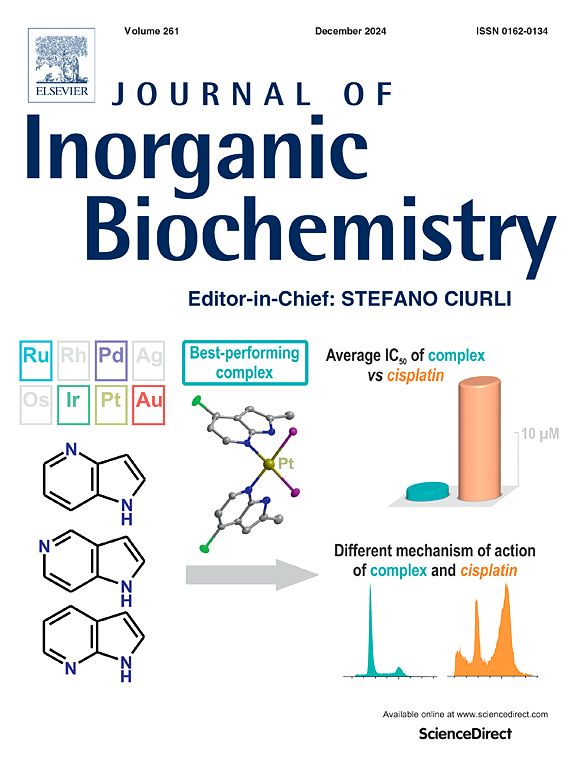1,10-菲罗啉增强了香豆素-硫代氨基脲杂化配体对Cu(II)和Zn(II)金属配合物的抗寄生活性和选择性
IF 3.2
2区 化学
Q2 BIOCHEMISTRY & MOLECULAR BIOLOGY
引用次数: 0
摘要
由克氏锥虫引起的恰加斯病仍然是一个主要的公共卫生问题,治疗选择有限,而且与目前的治疗方法相关的毒性很大。本文合成了8种新型杂电性配合物[M(L)(phen)],其中M = Cu(II)或Zn(II), L =香豆素-硫代氨基脲杂化配体,phen = 1,10-菲罗啉,并在固体和溶液中进行了表征。为了进行比较,还制备了一些同感的[Cu(HL) 2]、[Zn(HL) 2]和[CuCl(HL)]配合物。对所有化合物进行体外抗克氏锥虫实验。邻菲罗啉共配体的存在显著增强了这两个金属系的锥虫活性。[Cu(L)(phen)]配合物的效价最高,具有亚微摩尔半最大抑制浓度值和良好的选择性指标。机制研究表明,这些铜配合物增加细胞内活性氧,引起线粒体膜去极化,导致坏死是寄生虫死亡的主要机制。铜的氧化还原活性可能有助于这种增强的活性。这些发现强调了菲罗啉在调节抗寄生虫功效方面的相关性,并支持进一步开发含该配体的铜基配合物作为治疗恰加斯病的潜在药物。本文章由计算机程序翻译,如有差异,请以英文原文为准。

1,10-phenanthroline enhances the antiparasitic activity and selectivity of Cu(II) and Zn(II) metal complexes with coumarin-thiosemicarbazone hybrid ligands
Chagas disease, caused by Trypanosoma cruzi, remains a major public health concern with limited therapeutic options and significant toxicity associated with current treatments. In this work, eight novel heteroleptic complexes of the type [M(L)(phen)], where M = Cu(II) or Zn(II), L = coumarin-thiosemicarbazone hybrid ligands, and phen = 1,10-phenanthroline, were synthesized and fully characterized in the solid state and in solution. For comparison, some homoleptic [Cu(HL)₂], [Zn(HL)₂], and [CuCl(HL)] complexes were also prepared. All compounds were evaluated in vitro against Trypanosoma cruzi trypomastigotes. The presence of the phenanthroline co-ligand markedly enhanced trypanocidal activity in both metal series. The [Cu(L)(phen)] complexes showed the highest potency, with submicromolar half-maximal inhibitory concentration values and favourable selectivity indexes. Mechanistic studies revealed that these copper complexes increased intracellular reactive oxygen species and caused mitochondrial membrane depolarization, leading to necrosis as the primary mechanism of parasite death. The redox-active nature of copper likely contributes to this enhanced activity. These findings underscore the relevance of phenanthroline in modulating antiparasitic efficacy and support further development of copper-based complexes bearing this ligand as potential agents for Chagas disease treatment.
求助全文
通过发布文献求助,成功后即可免费获取论文全文。
去求助
来源期刊

Journal of Inorganic Biochemistry
生物-生化与分子生物学
CiteScore
7.00
自引率
10.30%
发文量
336
审稿时长
41 days
期刊介绍:
The Journal of Inorganic Biochemistry is an established international forum for research in all aspects of Biological Inorganic Chemistry. Original papers of a high scientific level are published in the form of Articles (full length papers), Short Communications, Focused Reviews and Bioinorganic Methods. Topics include: the chemistry, structure and function of metalloenzymes; the interaction of inorganic ions and molecules with proteins and nucleic acids; the synthesis and properties of coordination complexes of biological interest including both structural and functional model systems; the function of metal- containing systems in the regulation of gene expression; the role of metals in medicine; the application of spectroscopic methods to determine the structure of metallobiomolecules; the preparation and characterization of metal-based biomaterials; and related systems. The emphasis of the Journal is on the structure and mechanism of action of metallobiomolecules.
 求助内容:
求助内容: 应助结果提醒方式:
应助结果提醒方式:


